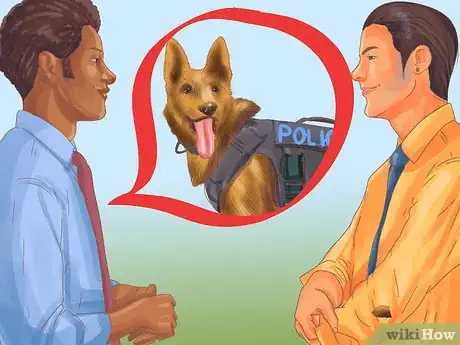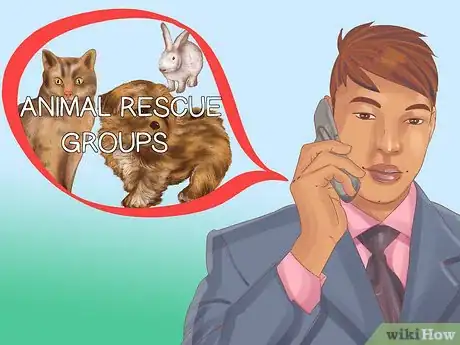This article was co-authored by Pippa Elliott, MRCVS. Dr. Elliott, BVMS, MRCVS is a veterinarian with over 30 years of experience in veterinary surgery and companion animal practice. She graduated from the University of Glasgow in 1987 with a degree in veterinary medicine and surgery. She has worked at the same animal clinic in her hometown for over 20 years.
This article has been viewed 24,792 times.
A personal protection dog has been trained to defend you in the event you are attacked or threatened by another person or animal. Personal protection dogs have received special training and are either sold by the organizations who trained them or by law enforcement agencies. In some cases, personal protection police dogs, also known as K-9s, are sold after they are no longer needed to help serve a particular law enforcement agency. Consider your reasons for wanting to buy a personal protection dog, and research online and through word of mouth to locate a reputable seller.
Steps
Researching Personal Protection Dogs
-
1Consider why you need a dog for protection. Trained protection dogs can be expensive and difficult to care for. They are specifically trained to protect you, your valuables, or your home in cases of danger, and are therefore altogether different than an ordinary guard dog.[1]
- A personal protection dog is more like a police dog or K-9 unit in terms of training and purpose. The major difference is that they are used in a defensive manner, rather than offensive. In other words, they’re intended to defend you rather than go after a criminal.
- Make sure your protection dog is trained for defensive purposes, especially if you go for a retired police or military dog. Ask its former handlers if they believe the dog might go on the offensive and become a neighborhood nuisance.[2]
- Consider purchasing a protection dog if you are a high profile figure, are under an authentic security risk, are in possession of a high-value or irreplaceable item, or suffer from a disability.
-
2Assess your family situation. It’s difficult for a dog to be a protection dog and a family pet at the same time. If you have young children in the house, you probably shouldn’t buy a protection dog. There have been several instances where protection dogs have severely injured or killed young family members.Advertisement
-
3Make sure you have the resources to purchase and keep a dog. Purchasing a trained personal protection dog can cost from a few hundred to several thousand dollars. In addition to upfront cost, it can cost several hundred dollars a year to pay for food, veterinary care, and incidental costs. Further, like all large dogs, they require substantial space, routine exercise, and an owner who can play the alpha role.[3]
- If you cannot fulfill all of these obligations, purchasing a protection dog or other large dog may not be appropriate.
-
4Choose a breed. While searching for a personal protection dog, you’ll likely come across numerous breeds available for purchase. However, two particular breeds stand out as the best in terms of trainability, reliability, temperament. You should therefore consider purchasing either a German Shepherd Dog or a Belgian Malinois as a personal protection dog.[4]
- These breeds are most often used as protection dogs or K-9 units by police and military.
- When considering the breed of the dog, you should also attend to its lineage. When you talk to a trainer or seller, ask if the dog’s family line was also used for protective services. Preferably, your protection dog should be bred from a line of dogs used for similar purposes.
-
5Be aware of your responsibilities or restrictions. Consider whether your homeowner’s insurance or other insurance policies will allow you to own a specific breed of dog, particularly one trained for protection. Familiarize yourself with your legal responsibilities in the event your dog bites someone, whether or not that person is intruding on your property or threatening you.
- Check the Animal Law Resource Center to find information about state and local laws: http://www.animallaw.com/
- Some insurance policies and some legal jurisdictions prohibit breeds labeled as “aggressive.” Double check both of these, as well as your homeowner’s association, apartment complex, or any applicable governing body.
- If you are not on the premises at all times to control the dog, you may be liable if an intruder is harmed. To avoid legal issues, make sure your dog is well trained and supervised when working.
-
6Consider the level of training you require. Know that there is a difference between a guard dog and a personal protection dog. A guard dog is simply intended or trained to bark in instances of danger. A personal protection dog, on the other hand, is trained to attack, bite, and scratch in order to protect you or your valuables.[5]
- If you’re an inexperienced dog handler, you probably shouldn’t get a protection dog because of liability issues. In order to handle a dog trained at that level, you’ll need significant experience with reward-based obedience training.
- Keep in mind that a dog that's received a lot of obedience training but hasn't trained specifically for protection services will hesitate and defer to its owner’s judgment in the event of an emergency. If your potential dog is actually trained for protection services, it will respond more to its surroundings.
- When you find a trainer or seller, ask them about how to maintain and care for a trained protection dog. A dog that’s been trained beyond your abilities may not be the most appropriate choice.
Finding a Trainer or Seller
-
1Consult with law enforcement offices in your area. Ask your local police and other law enforcement agencies about reputable trainers and sellers. Look for a local agency with K-9 dog units to provide you with recommendations.
- Ask your local law enforcement office where their K-9 dogs are purchased or trained.
- Ask them for local statistics or for a professional opinion regarding purchasing a dog for protection or a crime deterrent.[6]
-
2Contact local animal shelters or animal rescue groups. Ask your local animal shelters and rescue groups if they can provide you with any specific information about local protection trainers or sellers. Ask for names of organizations or trainers in your area who specialize in training or selling personal protection dogs.
- If no nearby shelters can provide you with a referral, ask them to put you in touch with a reputable trainer in your area.
- Ask the trainer for a referral and for more information about how a protection dog can meet your specific needs.
-
3Search online for trainers or organizations. Hundreds of individuals and small businesses train and sell guard dogs, K-9 police dogs, and personal protection dogs. Search keyword phrases such as "buy personal protection dog," "personal protection dog for sale," or “retired police or military dogs.”
- Make a list of your top returns, and check their websites for signs of credibility. Look for professionally designed websites and discard results that contain spelling or grammatical errors.
- Look for trainers or sellers whose websites offer testimonials from past clients.
- Find trainers who are certified with organizations such as the Animal Behaviorist Society or International Association of Canine Professionals. If their website offers any certifications, be sure to run a search on that organization.
- Before contacting any prospective sellers, ask your local law enforcement or a local licensed trainer if they’ve heard of that seller.
Purchasing a Personal Protection Dog
-
1Verify that the dog suits your needs. Discuss your specific needs with the prospective seller and make sure they can offer a dog that will provide adequate personal protection. The meaning of "personal protection" may vary from trainer to trainer, so be sure to ask about specific training methods and techniques. A dog trained only to bark, bite, and release might not fit your security needs.[7]
- Ask the trainer or seller to perform a demonstration with the dog before purchasing.
-
2Shop around and compare prices. Since a personal protection dog can be an expensive investment, don’t buy from the first seller you find. Spend considerable time researching different sellers, and shop around for better prices.
- Consider quality of training and the seller’s level of professionalism when you think about price differences.
- Just because a trainer or seller markets their dogs as “elite” or “executive” doesn’t mean you should pay a higher price. These buzzwords are typically marketing ploys.[8]
-
3Make sure the dog is in good health. Ask for detailed vaccination and veterinarian examination records. If you're buying from a breeder, make sure the dog's parents were screened for genetic disorders, parasites, and developmental disorders.[9]
- Consider the dog's age, and be aware that the breeds recommended for protection live around 10 to 12 years on average.
- Be aware of breed-specific conditions. For example, if you're buying a German Shepherd, consider hip problems. When the dog is in a standing position, check to see how much higher its shoulders are than its hips. If the hips are noticeably lower, ask for details about how well the dog moves and runs. Ask if it's ever been treated for hip problems, and ask for a vet exam before finalizing the purchase.
- If the dog is a retired police or military dog, pay special care to look over its veterinary record for injuries or health conditions developed over time. Get a vet exam before finalizing the adoption or purchase, and ask your vet if the dog is healthy enough to offer effective protection.
-
4Ask for instructions on handling the dog. If you are not experienced with handling a personal protection dog, you will need training or resources in order to properly handle the dog. Ask the prospective seller what materials or classes they offer to help you become accustomed to caring for and handling the dog.[10]
- Ask the seller if the dog will need ongoing training to provide personal protection.
- If ongoing defense training is needed for the dog, determine the costs and frequency of the training upfront before purchasing the dog.
References
- ↑ http://www.petmd.com/dog/training/evr_dg_attack_dogs_versus_guard_dogs
- ↑ http://www.slideshare.net/gwbradshaw12/buying-a-personal-protection-dog-what-you-need-to-know
- ↑ http://www4.ncsu.edu/~n51ls801/securitydogs.html#fnB11
- ↑ https://www.linkedin.com/pulse/dos-donts-buying-protection-dogs-patriot-k-9-services-
- ↑ https://www.linkedin.com/pulse/dos-donts-buying-protection-dogs-patriot-k-9-services-
- ↑ http://articles.baltimoresun.com/1994-01-03/features/1994003172_1_guard-dogs-dog-trainers-training-dogs
- ↑ https://www.linkedin.com/pulse/dos-donts-buying-protection-dogs-patriot-k-9-services-
- ↑ https://www.linkedin.com/pulse/dos-donts-buying-protection-dogs-patriot-k-9-services-
- ↑ http://www.humanesociety.org/issues/puppy_mills/tips/buying_puppy.html
About This Article
If you are a high profile figure, disabled, or in possession of expensive valuables, you may want to buy a retired police or military dog for personal protection. However, if you have young children in the house, you probably shouldn't get a protection dog, since it may not be a safe family pet. To find a personal protection dog, ask your local law enforcement about reputable trainers and sellers to contact. You could also ask a nearby agency with K-9 dog units where their dogs are purchased or trained. Make sure to shop around, compare prices, and ask sellers for a training demonstration, so you can determine which dog will best suit your needs. For more advice from our Veterinary co-author, including how to find a trustworthy personal protection dog trainer or seller online, read on!
































































